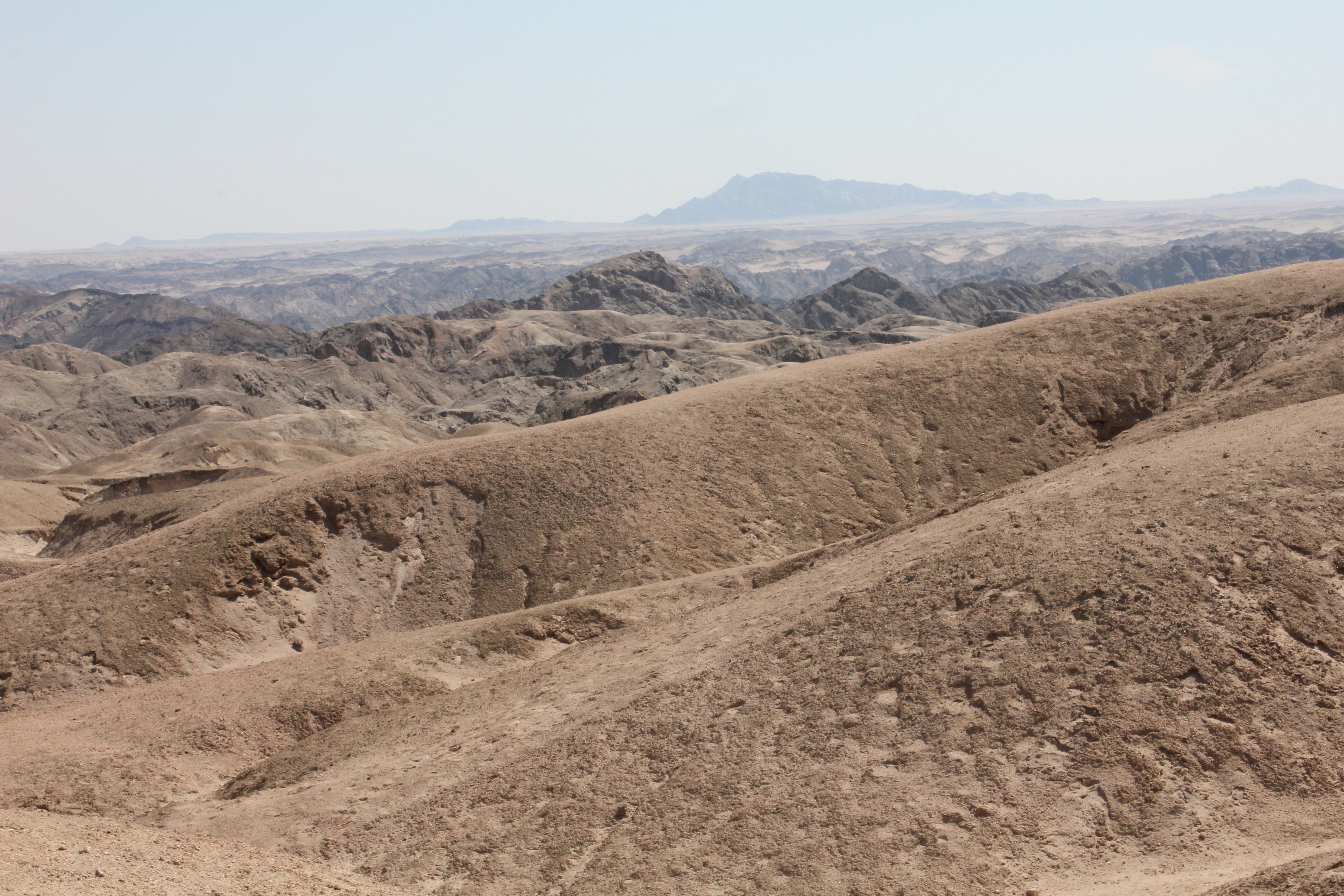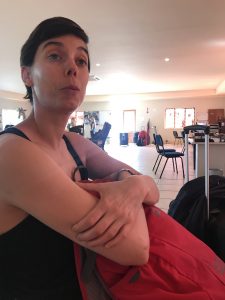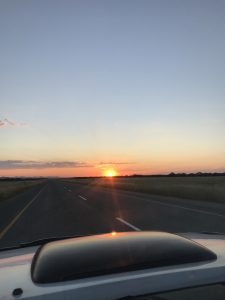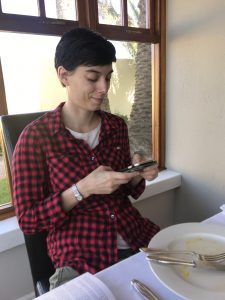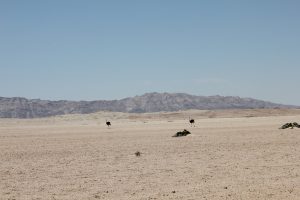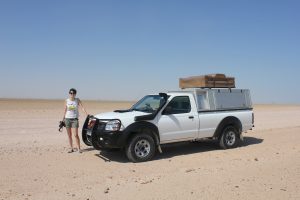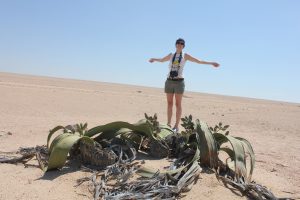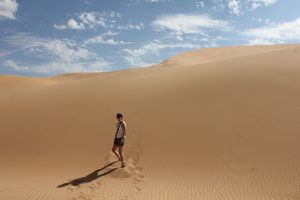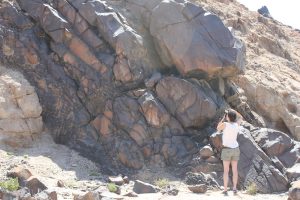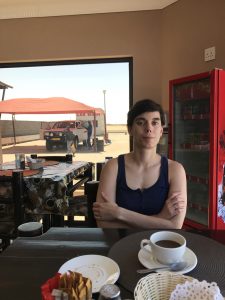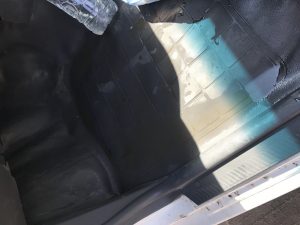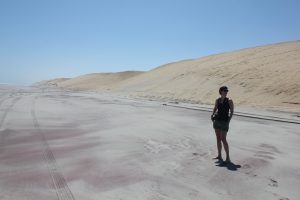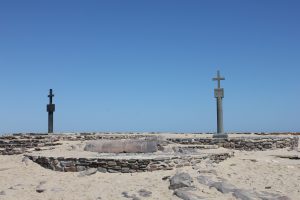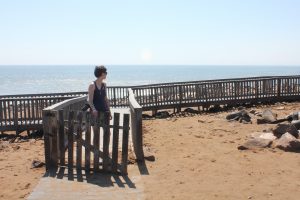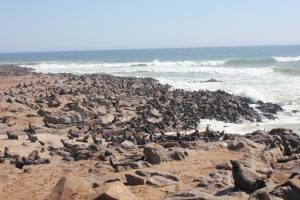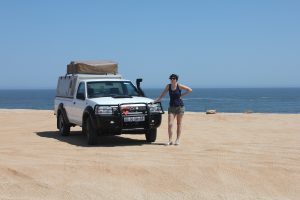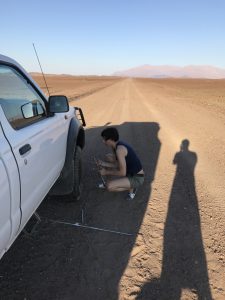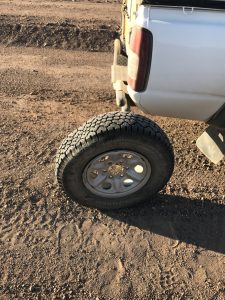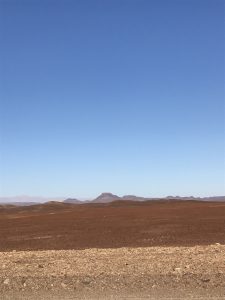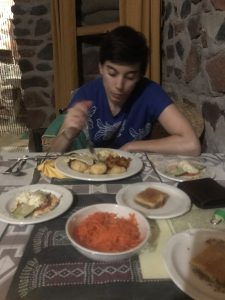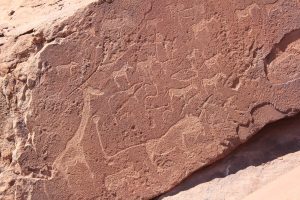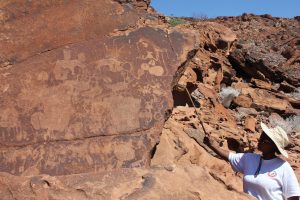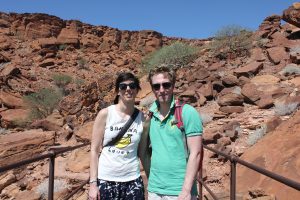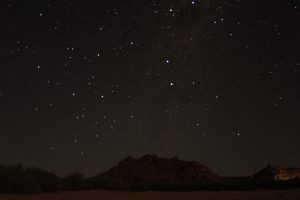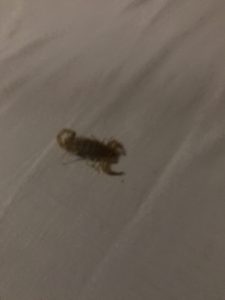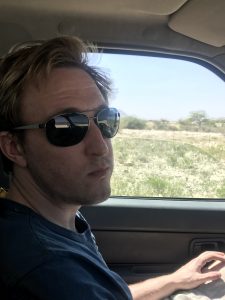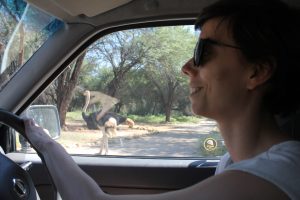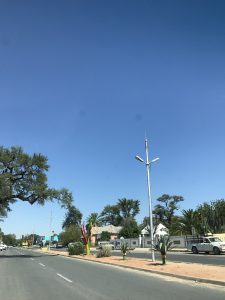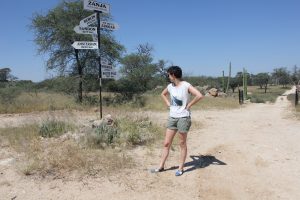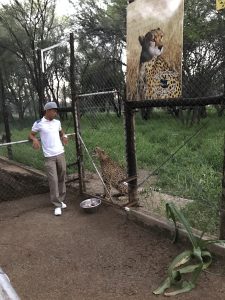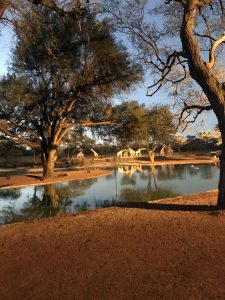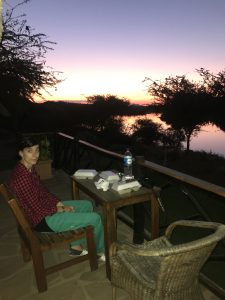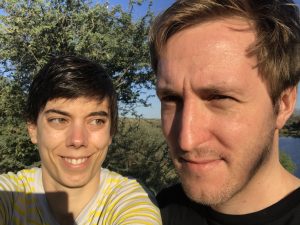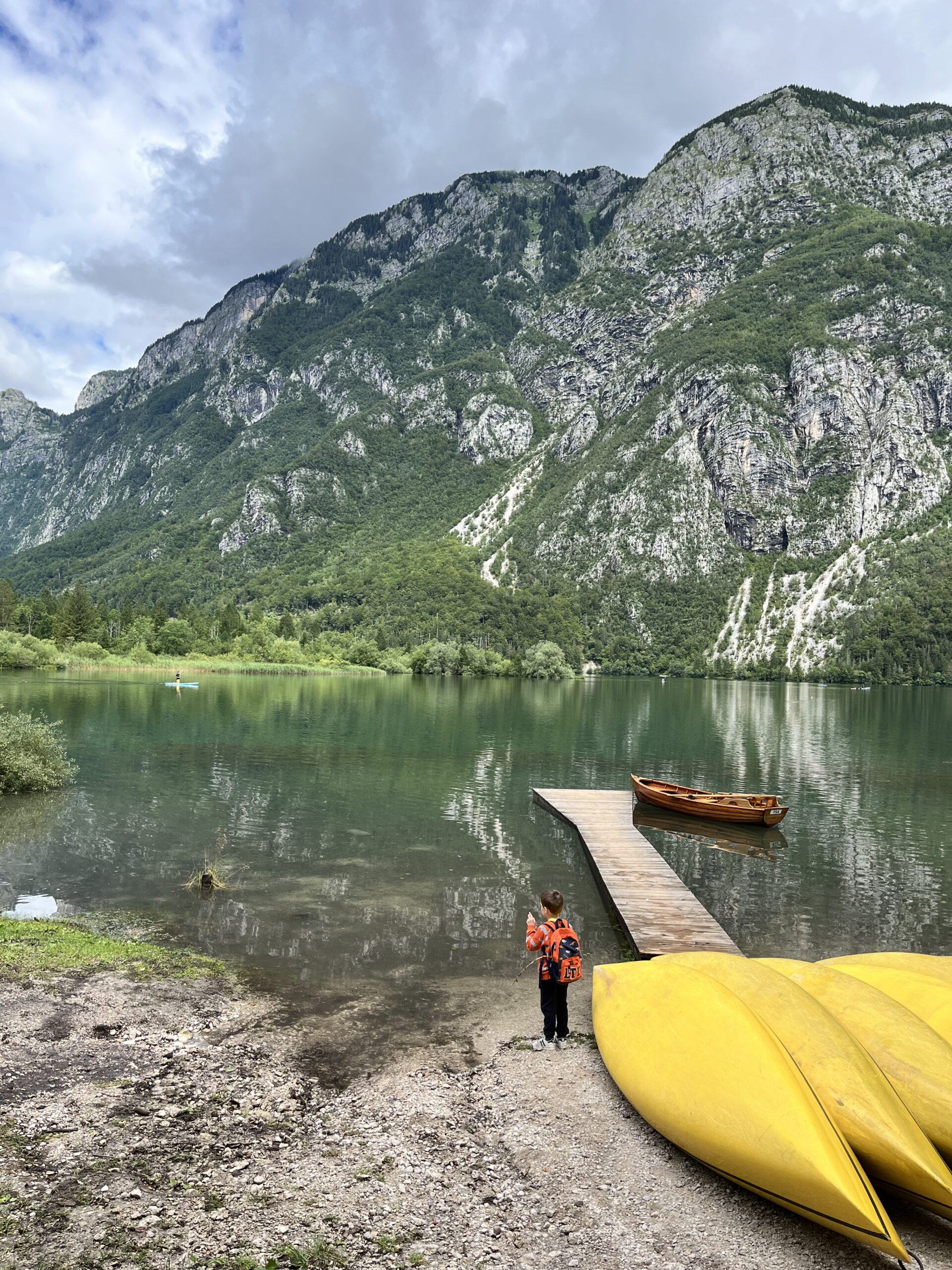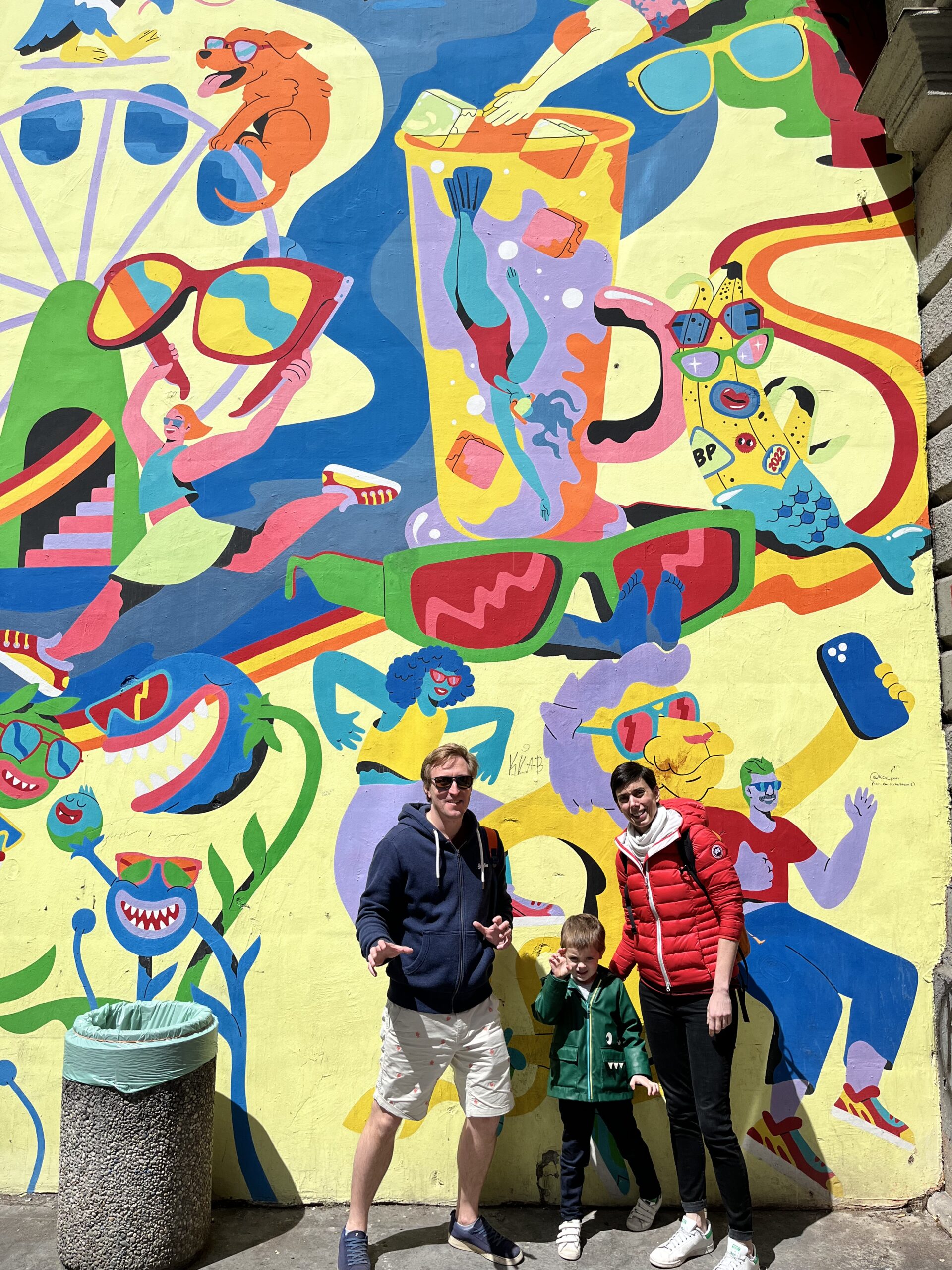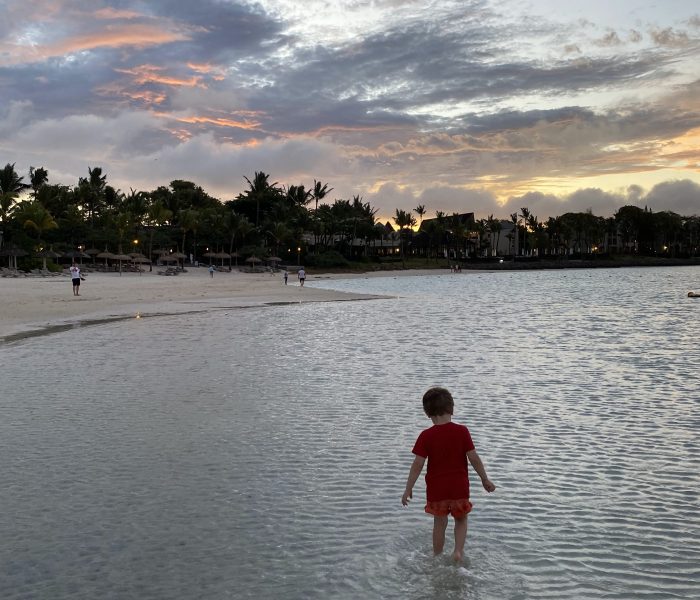Our Namibian trip was intended to be a short adventure in which we could see some of the vast and special sights of Namibia. It proved to tick all the boxes but at times was a pretty tough trip considering other places we have been, perhaps as Izaskun always says, we weren’t properly prepared.
Our trip started from a short 2-hour flight from Johannesburg to Windhoek. We landed in the small terminal where we proceeded to pass through the passport control which wasn’t very friendly at all, asking us to stand separately then proceeding to repeatedly ask us where and what we were doing in Namibia. Additionally, we had a group of girls in front of us that I can only describe as bimbos. They were noisy and decided to cut the queue much to the displeasure of the other people around, when confronted they called the others selfish and walked off.
Once we got through we proceeded to the car rental booth where we were informed that we had to wait for the guy to come pick us up. After a few minutes he arrived and proceeded to drive us to another location to collect the car. There we had to complete various papers and sign the same document about 5 times. After this we were told we had to get a demonstration of the car, which took about an hour (in hindsight this was pretty useful) but it was so frustrating as we just wanted to leave and we needed to drive to Swakopmund and it was already 4pm. Eventually we were ready to go, but we had to fill up the car with the guy. Annoying but fine, we figured it would be like 10 minutes. It took about 45 minutes as the car had a double tank, which means you cannot fill it up quickly as it overflows. Filling up the car generally took ages thou, as we found out later too.
Finally, we were ready to drive to Swakopmund which is about 400km. We weren’t happy to drive through into the night but we didn’t have much choice. We drove through Windhoek (as the airport is pretty far out of town) and proceeded to take the famous B2 road direct to Swakopmund. We enjoyed the lovely sunset along the way but for the last 2 hours of the trip we just saw darkness and the narrow road ahead.
We arrived to Swakopmund but struggle to find the guesthouse we were staying, named Cornerstone Guesthouse. This is because the GPS unit incorrectly positioned the street address. After a couple minutes we figured it out and found the place, fortunately it was on the same road and the town is pretty small. So after a long trip we were ready to retire for the night.
The next morning, we woke up and decided to explore the immediate area. We walked to the local supermarket, Pick ‘n Pay. All the shops around looked like South African chains, apart from a few small corner shops. We then proceeded to drive to see the Welwitschia Plains which we were around an hour drive. The route is famous for the various Welwitschia plants that grow there, especially one plant that is estimated to be 1500 years old!
So, we took off and drove into the desert, it was a surprise for us to see the landscape as the night before it was totally dark and we could not see anything. The landscape is bare and barren, and of course hot. It has a somewhat charm to it but it is also a scary sense from its harshness perspective. At this point we started having some dripping from the car, under the glove box. It was incredibly hot outside so we figured it could be some form of condensation inside the car, as we had the air-con on. We thought we would keep an eye on it and see how it goes as it was pretty far away to get it serviced.
After the desert drive, we decided to head back towards Swakopmund but proceed down the coast to Walvis Bay which was a strategic deep water port that it seems all the colonial powers in the past wanted to have (British, South Africans and the Germans), it was eventually given to Namibia in 1994, 4 years after their independence from South Africa. Today it appears to be a small quiet town that is still pretty much set on being a port where the port dominates most of the coast area of the town. There wasn’t much to see or do and essentially a drive through was enough to get an idea of the area. It did strike me as a bit of a South African town in terms of layout, street signs and overall look and feel. We proceeded a bit further south of Walvis Bay to see some famous sand dunes, most notably Dune 7.
A short 10km drive we arrived and proceeded to explore the area. It was insanely hot, clearly visible from the heat being emitted from the road (although this became a somewhat common sight over the next few days) and the lack of anybody nearby. We walked around and even tried foolishly to walk up the dune but we didn’t last long in the intense heat. Shortly we gave up and retreated to the coolness of the car with the air-con pushed up. Along the way we stopped to see how the beaches area and, of course, to test the waters. The water is apparently colder in Walvis Bay than further up the coast. It turned out that it was pretty cold. After our switch of heat and cold, it was our time to leave and retreat for the day.
That evening we decided to go out for a bite to eat, Izaskun identified a well known local place named Erich’s Restaurant. We called and booked a reservation, however when we walked to the place to find it, we couldn’t find it all, it was getting dark and really didn’t want to be lost in the middle of the night. So we walked around the block and street for a while until finally we gave up and decided to eat at a different restaurant. We picked a hotel named Hansa Hotel which was pretty interesting. It is a colonial German hotel, which still has the echoes, in terms of its decoration and company, of the early 19 hundred. It was a cute hotel that still seemed to serve German cuisine and guests. Dinner wasn’t served until 7pm so we had about 30 minutes to kill before we could eat, we decided to have a beer and they just so happened to have a special on a local version of a weissbier that we thought would be interesting to try, called Skeleton Coast weissbier. It turned out to be pretty horrible but we drank it regardless, although slowly. Eventually dinner was ready and we proceeded to eat, we tried to order more local food where Izaskun had a local fish dish while I had the kudu steak, which I would comfortably say the steak won. After a pleasant meal we proceeded home to rest up before our adventure up the Skeleton Coast.
The next morning, we woke up pretty early, for us, at 8am and proceeded to eat breakfast and check-out. We bought some basic essentials such as water and bread for the trip and then we drove up north, ensuring we also had a full tank of diesel.
At this point we started seeing the water dripping again from under the glove box again, so we decided to call the car rental place. The signal was pretty useless so we ended up driving to Henties Bay, the nearest town along the coast. Once we arrived, we spoke to the car rental company who informed us that we needed to take car into the garage for a repair. We found the only mechanic in the town along the main road, interestingly there were not street numbers as it was pretty obvious where everything is… on the main road. Houses a located on the side of the main road. We drove in and explained the situation, a mechanic came to take a look but couldn’t speak English, only Afrikaans. So we eventually were told that they needed around 30 minutes to look into and see what they can fix. We decided to go across the road to a café to have a coffee for 30 minutes. Eventually it turned out to be an hour but we managed to get it resolved. The town itself is remarkably impressive considering where it is, it isn’t very pretty, but it has the main facilities that you would need such as a café (with WiFi), petrol stations, liquor store and even a car wash – yes, a car wash in a place that has no water at all.
So back to the car, apparently the problem was a broken tube, which was dripping water and flooding the heating area. We were told that it was fine to drive but the car rental company should be made aware of this as they may need to replace the part. I called and explained it the car rental company but they didn’t seem to understand or care. We proceeded northwards to the Skeleton Coast, Henties Bay was the last town along the coast so it turned out be pretty convenient apart from the lose of time. We were conscious of not driving at night as the roads weren’t great and there are no street lights anywhere to be seen.
We drove for a while admiring the ‘nothing-ness’ of the surrounding area and stopping to see the beaches and even walking within the water to see how cold it was and compare it to Walwis Bay water. It was pretty cold compared to the hot sands surrounding it but probably the same temperature as what we had experienced the day before. The beach is constant throughout the Skeleton Coast and therefore it is possible to probably drive along the coast the entire way, although there is a good tar road only a few metres away which we and most people probably take. There are fishing points identified every 2km or so, each with their own names in Afrikaans. Some names are quite entertaining such as ‘Saint Nothing’ or ‘Big Hole’. It did appear that fishing was pretty popular in the area as every 10km or so we saw a car parked on the beach with fishing poles extended to the sea.
Eventually we arrived to an area named Cape Cross, which was the point that the first Europeans arrived but never settled, the Portuguese came in 1482 and erected a stone cross on the spot which still stands there today (well a replica does, the original was taken by the Germans). Cape Cross is also well known for its Cape Fur Seal breeding ground. After the formalities of paying to enter and having to demonstrate that I am indeed a South Africa (the lady wanted to charge me foreigner prices – simply unacceptable), we proceeded to drove to the ground. The first impression was the smell. The smell is so nauseating that Izaskun and I took a good 15 minutes to eventually get used to it and we weren’t even about 300m from the seals. We saw the famous Portuguese cross as well as a secondary cross which came later (around 1800s) in they do not know who erected it.![]()
Just a few metres down the road you could see the beginning of the seal camp, but once you turn over the ridge you are truly taken back by the number of seals there (as well as the noise and smell). For entire coastal area was simply seals pretty much as the eye can see. The seals have also taken advantage of the man made structures such as the wooden walk way and small sitting area, obviously in an attempt to escape from the heat. Along the seals were pups running around, crying for their mother’s attention and milk.
We suspected that the males had gone looking for food as we had read in the book that males will stay on land until the pups are born to defend their territory but once the pups are few months hold (they were born in December) they go out to replenish their body fat. Once we had managed to walk in the area that weren’t captured by the seals we proceeded back and left, being fascinated by the number of seals but also happy to escape their stench.
Further along the coast we drove past a point called mile 108, which is essentially a camping area for fishermen. There wasn’t much else to see beyond that point apart from what we had already seen of dunes, sand and the sea. Although we were surprised to see quite a few salt mines. Apparently the rocks are rich in salt which are mined and processed in South Africa. Many of the mines are still owned by South Africa. We also managed to see a desert fox randomly on the side of a dirt road while we were heading to the water.
After driving further past Mile 108 we decided to turn around and find the small side road that we needed to take to get to our destination that night. Turning around and driving a further 30km we found the D2303 road, which was a gravel road, the first of many to come. It turned out to be a pretty good gravel road where we could go around 60 / 80 km but after about an hour we needed to turn into another road, the D2342. This road was instantly worse and more narrow than the previous road. I, foolishly, thought the speed limit was the same so proceeded at around 60km, it was only a few kilometres down the road that I drove over a sharp prodding rock, that made a loud noise followed by a steady hissing sound.
I was worried what it could be, I stopped the car and confirmed what I was worried about. There was a puncture on the top right tyre and the air was rapidly escaping. I was worried I would incur the wraith of Izaskun but she was pretty calm, relatively. After a bit of work we gathered all the tools we needed and proceeded to replace the tyre. The whole thing took us roughly 45 minutes which actually wasn’t too bad, I suppose we did actually know what to do. It was a bit nerve racking as we didn’t have any cellular signal, stuck in a rocky desert with absolutely no-one nearby. It would have been pretty difficult if we weren’t able to change the tire. Fortunately for us we managed and we were back on the road towards our destination.
The only drawback now was that it was getting dark, and within Africa generally it gets darker a lot quicker than in Europe. So before we knew it, it was dark. Obviously there isn’t much in terms of light, even the moon was not in full force which meant we drove the next 3 hours or so in total darkness on pretty poorly managed roads that were mostly rocks, sand and gravel. Additionally, we needed to worry about animals coming out at night, this meant we drove around 40km per hour. Along the way we did manage to see one other car on the road, it turned out to be a very drunk local who lived nearby. He stopped and asked if we were alright and asked if we needed help. He was pretty kind and helpful but absolutely drunk which goes to show how the locals probably live, it was only about 8pm then. We parted ways and proceeded to drive slowly towards the remote lodge that we had booked. Along the way we attempted to call the lodge when we had signal to inform them that we were still coming, they seemed mostly concerned about us getting dinner.
Eventually we arrived, it was about 10pm and were exhausted and relieved to have finally managed the horrible drive. The staff of the lodge were about to go home so we were lucky to have just made it. They were even kind enough to provide us with take-away food so we could eat something before we sleep. The food was excellent, a tasty game steak as well as a generous serving of vegetables and desert. We devoured our dinner in our remote lodge which wasn’t much more than a 1 bedroom wooden (and thatched) room with an en-suite toilet. There were no plugs but at least we had lights and some warm water that is powered during the day through solar panels on the roof. Overall a good sustainable solution for living in the middle of no-where. We went to bed around 11pm and proceeded to pass out until the morning.
The morning cacophony awoke up early, around 5am, with the strange sounds of people and creatures outside. We weren’t used to this sound so it woke us up pretty quickly, although we did manage to snooze for a bit. Breakfast was served in the main building were we were the night before. This was also the place where we could charge our phones, as it was the only place that had plugs and running electricity. We proceeded to have a decent breakfast, most places seem to offer full English but this day I tried eggs and borewors (a typical South African sausage) which was ok but I suppose good considering we were in the middle of no-where. We planned our day, we were going to go to Twyfelfontein, which is a Unesco world heritage sight. There are bushman carvings and paintings that date back between 4000 and 6000 years ago. So, we set off but first we needed to fill up the car as we had driven quite a bit yesterday. This meant we had to drive to a town called Uis which was a bit out of the way, which wouldn’t have been an issue if we had tarred road but we haven’t seen one of those for nearly 24 hours now. So it took us a while to drive to the petrol station and fill up. While at the station we were encountered by a local crazy, probably high on something. He proceeded to harass us as well as the other customers. Fortunately the police promptly arrived and removed him. So finally we were able to drive to Twyfelfontein.
After a 3 hour or so drive we arrived. It was about 2pm and it was hot, it was around 38 degrees. We parked the car and were informed that the whole tour is about 45 minutes. It wasn’t too bad of a walk but it was it was just very hot which makes anything difficult. We proceeded to pay for our visit (nothing is for free!) and waited for the tour guide, which was mandatory. The tour guide was surprisingly friendly and articulate. She proceeded to tell us more than just the bushman carvings but also about life in Damaraland (the region were in). As you can imagine, water is difficult there and her local village has not had a working well of 6 years, so each day they receive 25 litres from the nearby game lodge who have a borehole. It made us realise we are to have running water and pretty comfortable existent, especially as they needed to also worry about roaming elephants coming into their village too.
The tour was very interesting and we proceeded to see many carvings, they appeared to just be everywhere but they had a great range in terms of dates between each. It was also fascinating to see such creatures as penguins and even seals, especially as there was nothing around us but rocks and sand. Apparently several thousands of years ago the land was a fertile land with a lot of water which would explain the abundance of animals and hence animal carvings.
So after some exploration and touristy photos, we proceeded back to the car pretty happy to escape the relentless heat. In the car we drank water and hate some tomatoes to try to replenish ourselves but unfortunately everything was warm. It was time for the air-con and the long drive home. We use our GPS to find the quickest way home, which we started to figure out that the GPS sometimes to direct us on the least logical route. We followed the GPS through a dirt road and even through a dried up river, even thou we believed there was a ‘main’ gravel road that would have been faster. Oh well, at least it was fun to use the 4×4 mode on the car through an old river bed. After a few hours were home again and happy to chill a bit. I proceeded to have a swim in the pool at the lodge, yes they had a basic pool even though we were in the desert, something that Izaskun found a bit unsustainable. We relaxed and had a local beer which never tasted so good in the heat, even the air was warm which ensured that I dried pretty quickly after the swim. We decided that we were like to eat dinner in our little one bedroomed lodge which the staff were happy to pack up our food for takeaway, after getting the owner to approve it.
That night we ate dinner and admired the stars which really come out when it is dark, I don’t believe either of us have managed to see the stars and milky way as clearly as we did there. After some admiration we were tired, probably from the heat, and proceeded to go to bed at 9pm. It was hot and difficult to sleep in the heat but eventually we managed.
At around 2am I had a sharp pain just above my knee, I was pretty surprised and thought that a bee had stung me, even though I had a mosquito net around the bed. It turned out to be a scorpion once we rolled back the blanket. Not a good sight to see at that time of night. Us, being totally ignorant on the local insects and what would be considered to be dangerous were, let’s say, a bit worried. We took the car out and went to the main lodge to see if we could find anyone. Of course, no-one there. We walked around the premises and eventually found a house which belonged the owner. We knocked on the door and luckily the owner’s daughter answered the door. We apologised and explained why we were there. The owner came out, a heavy Afrikaner woman, and looked at me and asked about the scorpion. She said that by now I would have a bad reaction if it was dangerous, good news – kind of. She informed that the yellow scorpions (which one had stung me) were less dangerous as the black ones and gave me some cream from African potatoes that was meant to help the swelling. Feeling better in this news we went back to the room and had a difficult time sleeping battling mosquitos and even trying to sleep in the car. Eventually we did sleep for the few remaining hours and fortunately my leg wasn’t too bad.
The next day we ate breakfast and spoke to the owner again. She mentioned that she was happy to see me still alive, a reassuring joke. We were happy to leave, not because of the location but rather we were of course too soft for this landscape, or at least I am. We packed and were on the road again, stopping in Uis again to fill up. This time a huge truck from Norway was filling up. The driver was doing a huge trip from Durban (South Africa) all the way to Norway. Interesting to see a massive truck in the middle of no-where. The wheels were pretty much half the size of our little car. We wished him luck and proceeded to Omaruru, which was the next stop on our roundtrip.
Our drive to Omaruru was relatively painless and uneventful apart from a slight random detour through a gravel road and a small town, in which we could understand why again, the GPS diverted us to. Omaruru is a cute town with an artist flair and definitely a lot more people and buildings than Brandberg. We were instantly struck on how much more vegetation there was too.
We drove through the town centre and even managed to use an ATM to extract some cash. We filled up the car again and proceeded down another dirt road for another few kilometres, common theme. However, this time the road was a lot better and more enjoyable.
We arrived to the Omaruru Game Lodge, its claim to fame is that it is owned by a Swiss owner and boasts an original architecture for the area. Once we arrived we thought it looked more like jungle camp with the row of palm trees, very nice but not very Swiss to me at least. Once we parked the car, after a bit of a mishap in terms the roof of the cark park, we checked in and proceeded to the room. We unpacked a bit, had a siesta and a swim in the pool that was pretty cold (again weird for us considering where we were). Dinner was to be served at 6pm but in the meantime we wanted to connect to the WiFi, however it didn’t work. Again, this was a common theme that we encountered. Mainly placed advertise WiFi but they don’t have it. The owner of the lodge told us it was an issue with Telkom (the same telecommunications provider as in South Africa) and continued to elaborate about how certain people don’t seem to work or look after the good of the country.
The lodge had a resident cheetah (shot by farmers when she was a cub) and leopard that were captured when they were young and aren’t able to be released back into the wild. They are fed each day at 6pm which appeared to be a bit of a tourist attraction but we figured it was for a good cause so it couldn’t have been too bad. It was interested to see how the cheetah reacted to the young man who fed her, didn’t seem to grateful but then again it is still a wild animal. It was also scary how easily the animal could blend in within its local surroundings, it could be easily a few metres away and we wouldn’t have noticed. After feeding the cheetah we followed the young man to the leopard cage, he dumped the meat but informed us that the leopard wouldn’t come out until dark, which would be nearly impossible to see it as it would be very dark. We didn’t really want to hang around in the dark outside the main lodge area so we headed back and got ready for dinner.
Dinner is served along a central lake that the lodge again feeds the local animals, so it makes for a specular sight of giraffes, bucks, ostriches, ducks and even rhinos. It did again seem to be a local attraction and perhaps a bit fake but still impressive to see. It was especially impressive to sit with the spotlight shining on the animals feeding and drinking while being served your own food, ironically some it being game meat. Overall it was a good meal and we managed to get some wine that was excellent too. We walked around after the meal and then proceeded to retire for the night.
Our last full day we decided to be nearby the airport, well near-ish. We found a place named Oanob which boasted the largest dam in the country. It was built in 1990, the same year as their independence. We headed out from our luxury Omaruru Game Lodge accommodation, having enjoyed some better comfort than before. We had our breakfast and checked out. We were pleased to see tarred roads which drastically improved the comfort and speed of our trip. In around 2 hours were already at our destination.
The morning we woke up early-ish and promptly packed and made some instant coffee for the trip ahead. We wanted to arrive at the car rental place at 10am. Although our flight wasn’t until 2pm. We wanted to get enough time to drop off the car and knowing how long they took last time, we figured 2 hours would be more than enough. So at 8am we left the resort, we drove north through Windhoek and then eastwards towards the airport. We arrived around 10am to the car rental premises and proceeded to follow the laborious process. Fortunately we had insurance that covered tyres and windscreen but once we mentioned that we had a flat tyre the lady was pretty fast to want to charge us full price for it. It eventually was fine, as we had the insurance, but as in Africa… things take time. So after signing more documents and review more papers, we were told I had to drive to fill up the tank (as it is a double tank they cannot tell whether it is full or not). I went out with a worker of the company, he didn’t have a license so I had to drive. I filled up the tank, it was only around NAD130 (less than £10). We headed back and finally we were able to get to the airport after getting short shuttle service. We checked and were pleasantly surprised to see it wasn’t busy, so we breezed through and went to have a bite to eat in the café. Eventually we were ready to board and after a short flight we were back in South Africa, back to what we could call civilisation.
Thus the end to our short but fascinating trip around Namibia. In reflection, we realised how huge the country is and what items we take for granted. We also acknowledged that next time we should probably prepare a bit more and maybe go with others in case things don’t go as smoothly they had. Overall the trip was great and it was refreshing to be able to disconnect (literally and metaphorically), definitely a place that we would like to visit again and explore further, especially in the south region. Perhaps you will read another story here in the not so far future about a second trip to Namibia but until then you will need to be content with this one.
Categories: Holiday
Tags: Namibia.
